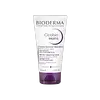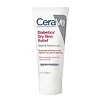What's inside
What's inside
 Key Ingredients
Key Ingredients

 Benefits
Benefits

 Concerns
Concerns

 Ingredients Side-by-side
Ingredients Side-by-side

Water
Skin ConditioningButylene Glycol
HumectantGlycerin
HumectantCaprylic/Capric Triglyceride
MaskingButyrospermum Parkii Butter
Skin ConditioningGlyceryl Stearate
EmollientGlycol Palmitate
EmulsifyingSodium Polyacrylate
AbsorbentPentylene Glycol
Skin Conditioning1,2-Hexanediol
Skin ConditioningCaprylyl Glycol
EmollientDipalmitoyl Hydroxyproline
Skin ConditioningMannitol
HumectantSodium Hyaluronate
HumectantXylitol
HumectantCitric Acid
BufferingRhamnose
HumectantSodium Citrate
BufferingAcetyl Dipeptide-1 Cetyl Ester
Skin ConditioningPolyquaternium-51
Skin ConditioningWater, Butylene Glycol, Glycerin, Caprylic/Capric Triglyceride, Butyrospermum Parkii Butter, Glyceryl Stearate, Glycol Palmitate, Sodium Polyacrylate, Pentylene Glycol, 1,2-Hexanediol, Caprylyl Glycol, Dipalmitoyl Hydroxyproline, Mannitol, Sodium Hyaluronate, Xylitol, Citric Acid, Rhamnose, Sodium Citrate, Acetyl Dipeptide-1 Cetyl Ester, Polyquaternium-51
Water
Skin ConditioningDicaprylyl Ether
EmollientCaprylic/Capric Triglyceride
MaskingGlycerin
HumectantBoron Nitride
AbsorbentGlyceryl Stearate
EmollientSilica Silylate
EmollientSodium Hydroxide
BufferingPolyglyceryl-3 Methylglucose Distearate
EmulsifyingVaccinium Myrtillus Fruit Extract
Skin ConditioningHydroxyethyl Urea
HumectantGlyceryl Stearate Se
EmulsifyingMyristyl Alcohol
EmollientCeramide NP
Skin ConditioningCeramide AP
Skin ConditioningCeramide EOP
Skin ConditioningCarbomer
Emulsion StabilisingSaccharum Officinarum Extract
MoisturisingCetearyl Alcohol
EmollientBehentrimonium Methosulfate
Sodium Lauroyl Lactylate
EmulsifyingCholesterol
EmollientPhenoxyethanol
PreservativeTocopherol
AntioxidantCaprylyl Glycol
EmollientCitrus Aurantium Dulcis Fruit Extract
MaskingCitrus Limon Fruit Extract
MaskingAcer Saccharum Extract
Skin ConditioningTrisodium Ethylenediamine Disuccinate
Xanthan Gum
EmulsifyingPhytosphingosine
Skin ConditioningEthylhexylglycerin
Skin ConditioningWater, Dicaprylyl Ether, Caprylic/Capric Triglyceride, Glycerin, Boron Nitride, Glyceryl Stearate, Silica Silylate, Sodium Hydroxide, Polyglyceryl-3 Methylglucose Distearate, Vaccinium Myrtillus Fruit Extract, Hydroxyethyl Urea, Glyceryl Stearate Se, Myristyl Alcohol, Ceramide NP, Ceramide AP, Ceramide EOP, Carbomer, Saccharum Officinarum Extract, Cetearyl Alcohol, Behentrimonium Methosulfate, Sodium Lauroyl Lactylate, Cholesterol, Phenoxyethanol, Tocopherol, Caprylyl Glycol, Citrus Aurantium Dulcis Fruit Extract, Citrus Limon Fruit Extract, Acer Saccharum Extract, Trisodium Ethylenediamine Disuccinate, Xanthan Gum, Phytosphingosine, Ethylhexylglycerin
Ingredients Explained
These ingredients are found in both products.
Ingredients higher up in an ingredient list are typically present in a larger amount.
This ingredient is an emollient, solvent, and texture enhancer. It is considered a skin-softener by helping the skin prevent moisture loss.
It helps thicken a product's formula and makes it easier to spread by dissolving clumping compounds.
Caprylic Triglyceride is made by combining glycerin with coconut oil, forming a clear liquid.
While there is an assumption Caprylic Triglyceride can clog pores due to it being derived from coconut oil, there is no research supporting this.
Learn more about Caprylic/Capric TriglycerideCaprylyl Glycol is a humectant and emollient, meaning it attracts and preserves moisture.
It is a common ingredient in many products, especially those designed to hydrate skin. The primary benefits are retaining moisture, skin softening, and promoting a healthy skin barrier.
Though Caprylyl Glycol is an alcohol derived from fatty acids, it is not the kind that can dry out skin.
This ingredient is also used as a preservative to extend the life of products. It has slight antimicrobial properties.
Learn more about Caprylyl GlycolGlycerin is already naturally found in your skin. It helps moisturize and protect your skin.
A study from 2016 found glycerin to be more effective as a humectant than AHAs and hyaluronic acid.
As a humectant, it helps the skin stay hydrated by pulling moisture to your skin. The low molecular weight of glycerin allows it to pull moisture into the deeper layers of your skin.
Hydrated skin improves your skin barrier; Your skin barrier helps protect against irritants and bacteria.
Glycerin has also been found to have antimicrobial and antiviral properties. Due to these properties, glycerin is often used in wound and burn treatments.
In cosmetics, glycerin is usually derived from plants such as soybean or palm. However, it can also be sourced from animals, such as tallow or animal fat.
This ingredient is organic, colorless, odorless, and non-toxic.
Glycerin is the name for this ingredient in American English. British English uses Glycerol/Glycerine.
Learn more about GlycerinGlyceryl Stearate is a mix of glycerin and stearic acid.
It is used to stabilize the mixing of water and oil ingredients. By preventing these ingredients from separating, it can help elongate shelf life. It can also help thicken the product's texture.
As an emollient, it helps soften skin and supports barrier-replenishing ingredients.
In cosmetics, Glyceryl Stearate is often made from vegetable oils or synthetically produced.
This ingredient may not be fungal-acne safe
Fun fact: The human body also creates Glyceryl Stearate naturally.
Learn more about Glyceryl StearateWater. It's the most common cosmetic ingredient of all. You'll usually see it at the top of ingredient lists, meaning that it makes up the largest part of the product.
So why is it so popular? Water most often acts as a solvent - this means that it helps dissolve other ingredients into the formulation.
You'll also recognize water as that liquid we all need to stay alive. If you see this, drink a glass of water. Stay hydrated!
Learn more about Water